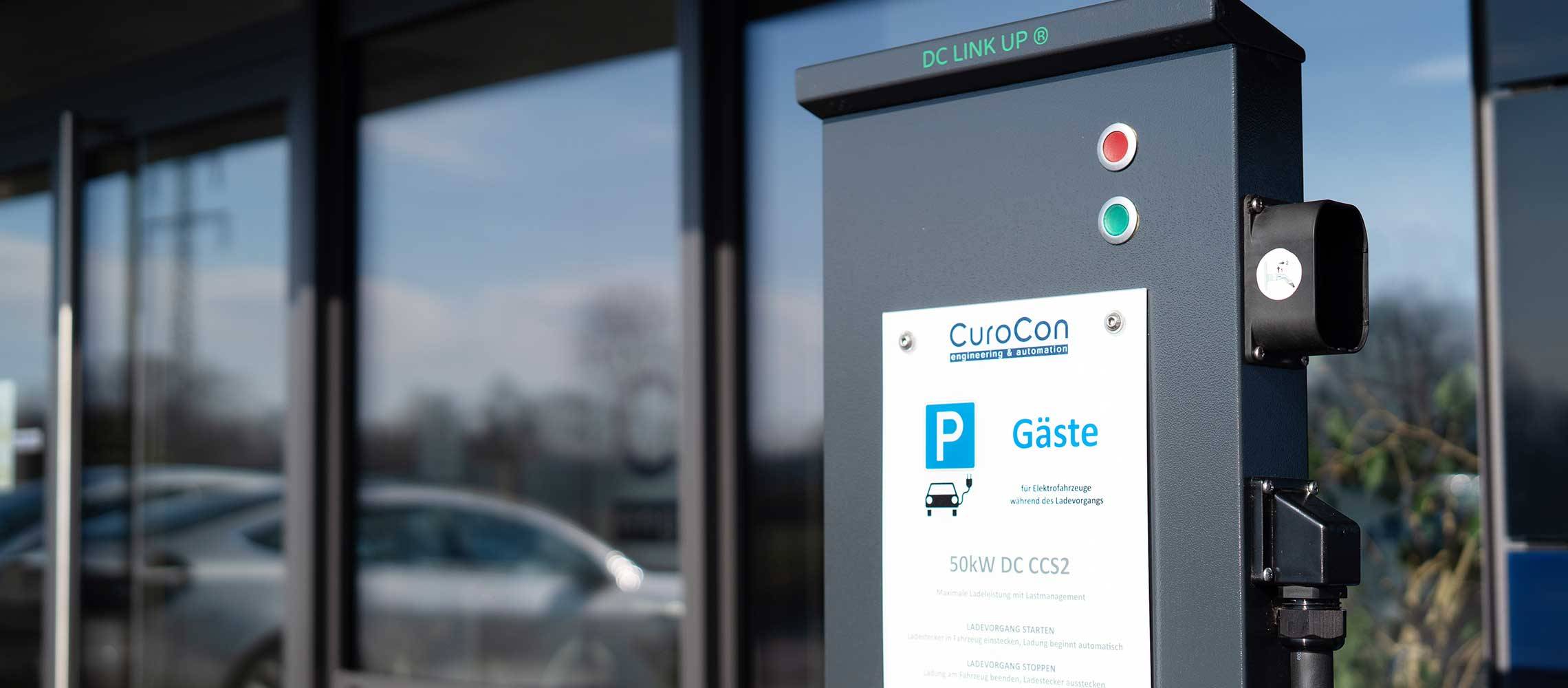The future of BEV charging
Bidirectional DC contactors by Schaltbau in the DC-Link-UP® by CuroCon

In this use case, you will learn more about the various modern charging-technology requirements and why bidirectional charging can bring electromobility to a new level.
The transition to climate-neutral mobility is making great strides. Government funding programmes support the development of high-performance overall systems for large-scale charging hubs, such as for public and non-public car parks or also for depots of electric commercial vehicles, such as electric busses and lorries.
CuroCon charging hub solution – flexible, customer-specific and scalable
In this application, CuroCon unites DC and AC charging points within a central control-cabinet-based charging system. The integrated industrial and freely programmable control system is designed for charging of electric vehicles in a standard-compliant manner. Due to this, the entire charging hub can be designed, scaled and freely combined from AC and DC charging points according to the individual customer requirements. The AC charging point consists of a terminal point for the charging cable – a communication gateway is built into the DC charging point at the terminal point, nothing more. All other electrical and electronic components are in the central switching system, which can also consist of several sub-systems.
Due to the continuously growing charging infrastructure – from just a few charging stations all the way to expanded charging hubs – focus is increasingly placed upon the question of providing a stabile power supply. Charging-hub planners must progressively master the challenge of achieving the optimal charging performance for each charging point with a limited grid connection. Functional load management is a prerequisite for this.
Here, CuroCon has integrated an intelligent requirement-orientated and dynamic load system based on a freely programmable control system. A multitude of available standard interfaces make communication possible with the customer’s own backend or charging-hub management system. The universal protocol, OCPP (Open Charge Point Protocol) can be integrated and can be used for charging-point activation and billing. The maintenance of component is performed on the central control cabinet – via remote diagnostics and remote support, a quick diagnosis and online updates are possible.
DC charging technology with the DC-Link-UP® Box – also for the bidirectional charging of tomorrow
The DC power elements are freely selectable in the charging system, thereby being upgradable for future requirements, such as bidirectional charging. This takes place via the integrated DC-Link-UP® Box, which connects the DC power elements to electric vehicles in a standard-compliant manner. Here, CuroCon relies on the C310 DC contactor by Schaltbau:
In the case of full bidirectionality, these must be capable of safely and reliably switching currents of up to 500 A both during battery charging and discharging.
What is understood by bidirectional charging and will it prevail in the future?
Bidirectional charging can be of invaluable benefit to the energy revolution. Electric automobiles can, for example, utilise their downtimes in a useful manner. At a low level of charging capacity, four to six hours is enough to charge the batteries of an electric car. In turn, 30 to 60 minutes is enough at quick-charging stations. During the rest of the time, the batteries are available for buffer storage. They can emit the current again, thereby serving as a flexible energy storage system, for example, in the event of energy-supply fluctuations from regenerative sources. This sophisticated “vehicle-to-grid” solution entails making as many electric cars as possible part of the power grid. One of Europe’s largest car automotive manufacturers wants to supply hundreds of thousands of vehicles with the capability of bidirectional charging – that could help the technology to make a widespread breakthrough.
Safety and scalability for the charging system by CuroCon
For the required scalability of its power-hub solution, CuroCon uses several C310 DC contactors by Schaltbau connected in series. There, they are impressive with a high level of power capacity, simultaneously having compact dimensions. In the event of an emergency, the contactors reliably switch off thanks to their high bidirectional breaking capacity and the high short-term rated power. With the integrated mirror contact function for switch-state monitoring, they ensure a high standard of safety for the entire system. From an economic perspective, undesired charging losses in the charging system can be significantly reduced since the C310 contactors have extremely low contact resistance levels, thereby preventing power unnecessary power loss.
About CuroCon:
CuroCon GmbH, with its headquarters in Zwingenberg, is specialised in engineering services and products for industrial applications in test-station and plant engineering, mobile automation for e-mobility and the electrification of commercial/private vehicles, as well as power automation in the field of energy/charging technology with associated load/energy management.
